Top 5 Things to See and Do in Guyana
August 4, 2018 - 4 minutes read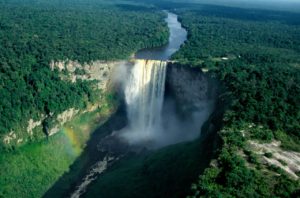 Referred to as the “Land of Many Rivers,” Guyana boasts more than 600 miles of navigable waterways to explore, along with rapids, waterfalls, Atlantic beaches, and vast tropical jungle and savannahs brimming with a spectacular array of birds and iconic wildlife.
Referred to as the “Land of Many Rivers,” Guyana boasts more than 600 miles of navigable waterways to explore, along with rapids, waterfalls, Atlantic beaches, and vast tropical jungle and savannahs brimming with a spectacular array of birds and iconic wildlife.
Kaieteur Falls National Park
Located deep in the Amazon rainforest, the national park is named for its main attraction — thundering Kaieteur Falls. Five times the height of Niagara Falls and one of the great natural wonders of South America, the cascade tumbles from a sandstone tableland into a deep valley, 741 feet below. Depending on the season, the falls can be 250 to 400 feet wide.
About an hour’s flight from Georgetown, the waterfall is surrounded by dense rainforest and a maze of trails that are best explored with an experienced guide or part of an organized tour. Even though the national park is Guyana’s most visited attraction, 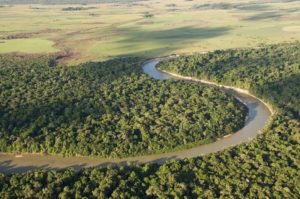 its immense size (242 square miles) means it often feels like you’re the only one there.
its immense size (242 square miles) means it often feels like you’re the only one there.
Iwokrama Rainforest
Covering more than 1,400 square miles of central Guyana, the vast Iwokrama Rainforest is one of the world’s most prolific ecosystems. The region is home to numerous species of bird, mammal, amphibian, insect and aquatic life, as well as a wide variety of trees, plants and flowers.
One of the main attractions for visitors is the four-deck Iwokrama Canopy Walkway which hovers around 100 feet in the air for a bird’s-eye-view of the surrounding forest. One million acres of the 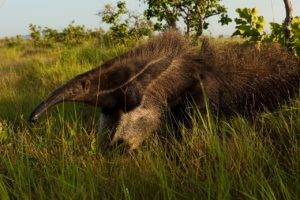 forest and local trail system to Turtle Mountain and other sights is managed by the nonprofit Iwokrama International Centre for Rainforest Conservation and Development.
forest and local trail system to Turtle Mountain and other sights is managed by the nonprofit Iwokrama International Centre for Rainforest Conservation and Development.
Historic Georgetown
Georgetown Guyana’s capital city — is located on the country’s Atlantic coast along the banks of the Demerara River. The city has tree-lined streets flanked by many historic Dutch colonial buildings and British Victorian architecture.
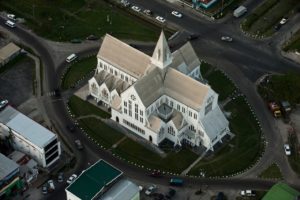
St George’s Cathedral — with its 132-foot spire — is reputedly one of the world’s tallest wooden structures, while St. Andrews Kirk (built it 1829) is the country’s oldest building continually used for religious purposes. Among the city’s other landmarks are the Walter Roth Museum of Anthropology and the Museum of Guyana with its collection of Guyanese paintings and sculptures.
The neo-classical Parliament Building was built in 1833 and is still where Guyana’s national lawmakers meet today while the cast-iron Old Stabroek Market offers a wide variety of goods for sale. For a peaceful respite in the city, check out the Botanic Gardens.
Shell Beach
Guyana’s most outstanding strand of Atlantic coast is Shell Beach, a lengthy stretch of sand that stretches all the way from the Essequibo Coast to the Venezuelan border. Still largely wild and undeveloped, the beach is most renowned for one of the best places on the planet to watch endangered sea turtles lay their eggs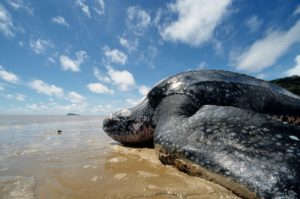 and the little ones scamper into the surf months later after they hatch. Four of the world’s eight sea turtle species — green, hawksbill, leatherback and olive ridley — nest at Shell Beach.
and the little ones scamper into the surf months later after they hatch. Four of the world’s eight sea turtle species — green, hawksbill, leatherback and olive ridley — nest at Shell Beach.
Rupununi Savannah
Located in the south of the country and surrounded by the Kanuku and Pakaraima Mountain Ranges, this vast grassy tropical plain provides a home to around 80% of the mammal species and 60% of the birds found in Guyana. Similar in size and function to Brazil’s Pantanal region, the Rupununi floods during the rainy season (May-August) and supports a traditional cattle ranching culture. The best way 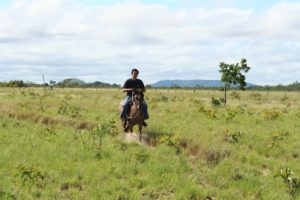 to explore the savannah is staying at one of the community-led and owned eco-lodges or at a working ranch that also supports tourism.
to explore the savannah is staying at one of the community-led and owned eco-lodges or at a working ranch that also supports tourism.
0 Comments